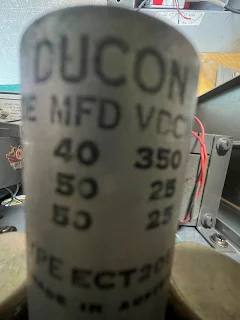This is an interesting little valve PA amplifier that I picked up today, probably from the late fifties or early sixties.
I don't think it will need too much work, but I'll find out soon enough. It's a little tight on space compared to some others, but not it's not as bad as some other point to point circuits that I've seen.
It has some unusual input and output connectors, and the output transformer has some very high impedance options that will need to be sorted out. Some of these old amplifiers were designed to run multiple speakers as a 100v line system, which means the output impedance can be extremely high - like hundreds of ohms and as the name suggests, it's putting out 100 volts. Not very friendly towards your average 8 or 16ohm speaker that is commonly found in guitar cabs.
AWA MODEL PA774 8 WATT VALVE PA AMPLIFIER
One microphone, one P.U. channel (for old school record players) with a tone control for the P.U. channel - just a basic low-pass filter.
8 watts, push-pull arrangement using 6BM8 (ECL82) valves. These are unusual in that each valve contains a single triode and a pentode. I think these are best known as being used in the Gibson GA-8T.
A single 12AX7 is used for the mic input and the P.U. inputs. The mic input has 2 gain stages, the P.U. only has one, as turntables back in the day had a much higher output.
It has an isolated negative feedback stage, taken from a separate winding of the output transformer, going to the cathode of the second 12AX7 gain stage.
Being a PA amplifier, I think this was just meant to be left on for extended periods of time - I say this as it does not have a power switch or even a light to know its on. They also skipped adding a fuse, so pretty bare-bones on the safety front.
AWA MODEL PA774 8 WATT PA AMPLIFIER SCHEMATIC
LEAKY CAPS & OUT OF SPEC RESISTORS
The large Ducon electrolytic capacitors still test well. I did spend some time reforming them on the variac.
Resistors
Quite a few resistors were well out of spec, most had to be replaced. Many were more than 25% over, there were even a few that were out by 100% Sometimes carbon comp resistors can still be within spec (10% or 20% - check the colour band) other times they can be so far out that it will effect the performance of the amp quite a lot.
CONVERSION MODS
FURTHER READING - TIM ROBBINS
If you've read this far into the post, you must be at least vaguely interested in Australian amplifiers, check out this site by Tim Robbins.
Tim has documented a huge number of amps that he has worked on in amazing detail, and unlike me and a lot of other people on the internet offering opinions, the guy is highly qualified and has authored and published numerous technical papers on electronics.



.jpeg)









1 comment:
wow that almost looks brand new, what a find, hope you have some fun with it
Post a Comment